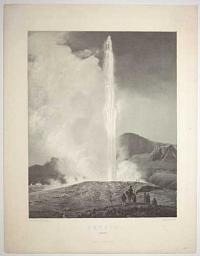
Geysir. (Island)
Emmanuel Larsen del. E. Vesterberg lith. Em Baerentzen & C.o lith Inst.
Em Baerentzen & C.os Forlag eneberettiget.
Lithograph, sheet 380 x 295mm (15 x 11½") very large margins.
A view of Geysir, the Icelandic geyser, erupting with people watching the spectacle.
[Ref: 57091] £180.00
(£216.00 incl.VAT)
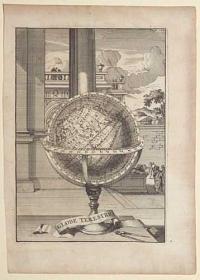
Globe Terrestre.
[Paris? n.d., c.1700.]
Engraving. 185 x 130mm (7¼ x 5"), large margins.
An illustration of a terrestrial globe, showing Europe and Asia, with a classical architectural background.
[Ref: 56829] £160.00
(£192.00 incl.VAT)
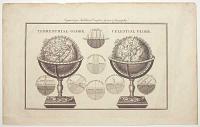
Terrestrial Globe. Celestial Globe. Engraved for Middleton's Complete System of Geography.
[London: J. Cooke, 1777-8.]
Engraving. 190 x 290mm (7½ x 11½"), with margins.
An illustration of a pair of globes with rococo stands.
[Ref: 57129] £70.00
(£84.00 incl.VAT)
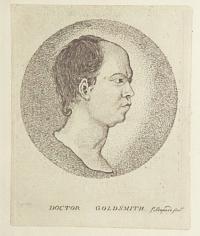
Doctor Goldsmith.
Poupard sculp.t [after Aundinet].
[Philadelpha, n.d., c. 1780].
Stipple. Sheet 105 x 85mm (4¼ x 3½"), large margins top and bottom. Trimmed to plate, laid on album paper.
A portrait of Oliver Goldsmith (1728-74), from an American edition of Goldsmith's work. By James Poupard of Philadelphia & New York, 1772-1814. See Wellcome 1160.
[Ref: 57211] £450.00

View of the Port of Goole, Taken in March 1828. Plan of the Port of Goole, with the Indended Improvements.
Geo. Leather, C.E. 1828.
[c.1828.]
Rare lthograph. Sheet 340 x 285mm (13½ x 11¼"). Trimmed to image upper left, folded horizontally.
A plan and view of the port of Goole by George Leather (1786-1870), who became Resident Engineer at the port in 1821.
[Ref: 56770] £260.00
(£312.00 incl.VAT)
![Vanity Fair Supplement. [Men of the Day No. 2219.]](img-thumbnail/jpegs/56969.jpg)
Vanity Fair Supplement. [Men of the Day No. 2219.] "Claudie." (C. Graham. White.)
Tec. Hentschel- Colourtype London
[n.d., 10 May 1911.]
Chromolithograph with supplementary text, sheet 380 x 260mm (15 x 10¼"), large margins.
Full length portrait of Claude Grahame-White (1879 – 1959) English pioneer of aviation, and the first to make a night flight, during the Daily Mail-sponsored 1910 London to Manchester air race. Grahame-White's interest in aviation was sparked by Louis Blériot's crossing of the English Channel in 1909. This prompted him to go to France, where he attended the Reims aviation meeting, at which he met Blériot and subsequently enrolled at his flying school. He was one of the first people to qualify as pilot in England. He reached celebrity status in April 1910 when he competed with the French pilot Louis Paulhan for the £10,000 prize offered by the Daily Mail newspaper for the first flight between London and Manchester in under 24 hours. Although Paulhan won the prize, Grahame White's achievement was widely praised.
[Ref: 56969] £130.00
(£156.00 incl.VAT)
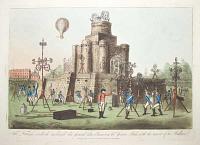
The Fortress (which enclosed the Grand Pavillion) in Green Park; with the ascent of the Balloon.
Published Aug. 24. 1814, by Tho. Palser. Surrey side West.r Bridge.
Fine hand coloured engraving plate 250 x 350mm (9¾ x 13¾") with large margins. Glued to early 19th century card.
On 1st August 1814 a series of events celebrating both the end of the Napoleonic Wars and the centenary of Hanoverian rule in England. This temporary structure was built in Green Park for a firework display: soldeirs bring in and set up fireworks under the command of an officer standing in the centre while a balloon rises over them.
[Ref: 56303] £320.00
![[The Grand Jubilee Celebrations in London's Parks.]](img-thumbnail/jpegs/49810.jpg)
[The Grand Jubilee Celebrations in London's Parks.] View of the Bridge and Pagoda, from the Canal, St James's Park.[&] The Chinese Pagoda and Bridge in St James's Park (previous to the Fire.) [&] The Fortress (which inclosed the Grand Pavillion.) in the Green Park; with the ascent of the Balloon. [&] The Grand Pavillion in Green Park. [&] The View in Hyde Park, with the Fleet at Anchor, on the Serpentine River. [&] The Jubilee Naval Action on the Serpentine in Commemoration of the Battle of the Nile. [&] The Action between the British & American Frigates on the Serpentine, Hyde Park, 1st August, 1814. [&] Scene on the Serpentine, Hyde Park, on the Night of the Grand Jubilee, Aug.t 1. 1814.
Published Aug.t 12 [& 24th], 1814, by Tho. Palser, Surry Side, West.r Bridge.
Eight etchings with hand colour. Each c. 245 x 345mm (9¾ x 13½"). Each plate trimmed to plate top and bottom.
On 1st August 1814 a series of events celebrating both the end of the Napoleonic Wars and the centenary of Hanoverian rule in England. In St James's Park a Chinese bridge with a pagoda was built over the lake; in Green Park a revolving Temple of Concord was constructed by Sir William Congreve (of rocket fame); and in Hyde Park naval battles with miniature frigates were fought (the 'Nile' and 'Trafalgar' against the French and a third against the Americans, a reminder that Britain was still fighting the War of 1812). The battles were successful events: however the pagoda in St James's Park was set alight by fireworks, killing one and injuring another; and the balloon ascent, by James Sadler (1753-1828, the first English balloonist) did not go as planned and he had to make an emergency landing.
[Ref: 49810] £2,500.00
view all images for this item

The Chinese Bridge on Fire, on the night of the celebration of the glorious Peace of 1814.
Published & Sold Aug.t 12th 1814, by Edw.d Orme, Bond St. London.
Coloured mezzotint, prepared as a transparency. 180 x 125mm (7 x 5"), Narrow margins, some staining.
On 1st August 1814 a series of events celebrating both the end of the Napoleonic Wars and the centenary of Hanoverian rule in England. In St James's Park a Chinese bridge with a pagoda was built over the lake; in Green Park a revolving Temple of Concord was constructed by Sir William Congreve (of rocket fame); and in Hyde Park naval battles with miniature frigates were fought (the 'Nile' and 'Trafalgar' against the French and a third against the Americans, a reminder that Britain was still fighting the War of 1812). The battles were successful events: however the pagoda in St James's Park was set alight by fireworks, killing one and injuring another; and the balloon ascent, by James Sadler (1753-1828, the first English balloonist) did not go as planned and he had to make an emergency landing. This print has been treated with oil and colour on the reverse to create more vivid colours when held up to a light.
[Ref: 53152] £190.00
(£228.00 incl.VAT)
![John Edw. Gray [facsimile signature].](img-thumbnail/jpegs/57191.jpg)
John Edw. Gray [facsimile signature].
T.H. Maguire 1851. M. & N. Hanhart Imp.t.
[Ipswich: George Ransome, 1852.]
Lithograph. Printed area 360 x 240mm (14¼ x 9½"), with wide margins. Foxing in margin.
Half-length portrait of John Edward Gray (1800-75), one of the most prolific taxonomists in the history of zoology. He was founder of the Entomological Society of London in 1833 (now the Royal Entomological Society). He was keeper of zoology at the British Museum 1840-1874 (before the department became the Natural History Museum. From the series 'Portraits of Honorary Members of the Ipswich Museum.'. Wellcome: 1202.
[Ref: 57191] £230.00
(£276.00 incl.VAT)
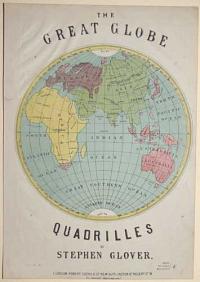
The Great Globe Quadrilles by Stephen Glover
[S. Rosenthal lith.]
London: Robert Cocks & C.o New Burlington S.t Regent S.t W. [n.d. c.1870]
Colour lithograph. 330 x 240mm (13 x 9½"). Trimmed with creasing in the top left corner and a small repaired tear in the upper left margin. Two worm holes in top left and bottom right corners.
An illustrated cover of the Eastern hemisphere for the sheet music to Stephen Glover's 'Quadrilles'.
[Ref: 56908] £190.00

The Great Telescope, (of 52 Feet focus. 6 feet clear opening of Speculum.) Erected at Birr Castle in Ireland by the Earl of Rosse, President of the Royal Society. Lord Rosse directing the Conveyance of the Great Speculum to iits position at the base of the Tube, North Side.
On Stone by W. Bevan from a drawing by Miss Henrietta Compton. Figurres by G. Herbert Herries.
[n.d. c.1850]
Tinted lithograph, image area 324 x 495mm. 12¾ x 19½". Sheet 470 x 629m. 18½ x 24¾". Two tears in title and one in left margin.
The real race for aperture was launched by William Parsons, the third Earl of Rosse. The Earl was a man of vast wealth, who owned extensive estates in Ireland. He was a passionate amateur astronomer, and like most amateurs, he needed a larger telescope. Money was not a hindrance for the Earl. He wanted to build the world's largest telescope, and he wanted it to be used by professional astronomers who would be able to properly access the discoveries which would be made. He decided to attempt a mirror six feet in diameter. The project began in 1843, but had to be suspended in 1845 due to the Great Potato Famine. By 1847 conditions had improved, and the telescope was finally placed into service. The team of professional astronomers which the Earl had engaged was headed by Sir Robert Ball.The telescope proved to be of amazing optical quality. But its light-gathering capacity was beyond all expectation. For the first time it was possible to detect stars as faint as 18th magnitude. The first subject of detailed examination was the Moon. Minute craters and rills which had never before been glimpsed were charted. Delicate new details were seen on Jupiter, Saturn, and Mars. After about one year of intensive study of the solar system, the telescope was turned to the stars. The big question which astronomers were asking in the mid-Nineteenth Century was 'Are the nebulae composed of minute stars which we cannot resolve because of their extreme distance?' The great telescope provided the first opportunity to try for a meaningful answer. It was not known at this time that there were different kinds of nebulae - some composed of stars, and some composed of gas and dust. After the Earl's death in 1867, his son, the Fourth Earl of Rosse continued his father's work. He fitted the telescope with a clock drive, and expanded the research with other (smaller) special-purpose instruments. Research on the heat content of the Moon was carried out over a 22-year period. The last observations were made with the 72' in 1878, and it was dismantled in 1908. It is interesting to note that this instrument was not surpassed in size until the 100' Hooker telescope at Mt. Wilson was placed in service in 1917. See ref 57216.
[Ref: 1421] £790.00
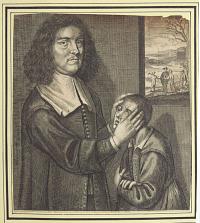
[The true and lively pourtraicture of Valentine Greatrakes Esq.r of Affane in ye Country of Waterford, in ye Kingdome of Ireland famous for curing several Deseases and distempers by the stroak of his hand only.]
[Sold by W.m Faithorne.] [n.d.,. 1666.]
Etching. Sheet 130 x 115mm (5¼ x 4½"). Trimmed into image, losing all text, top edged chipped, laid on album paper.
Valentine Greatrakes (1628-82), an Irish faith healer who toured England in 1666, claiming to cure people by the laying on of hands. A religious man, he started his healing in 1662 after feeling an impulse, curing Robert Phayre, a former Commonwealth Governor of County Cork, of acute ague in 1665. In 1667 he returned to farming in Ireland. The frontispiece of ''A brief account of Mr Valentine Greatrakes and divers of the strange cures by him lately performed''.
[Ref: 57203] £70.00
(£84.00 incl.VAT)
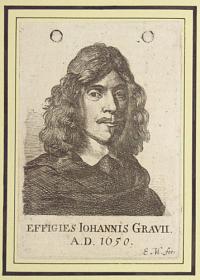
Effigie Iohannis Gravii. A.D. 1650.
E.M. [Edward Mascall] fec.
[n.d. c.1650].
Etching. Sheet 105 x 75mm (4¼ x 3"). Trimmed inside platemark, laid on album paper.
John Greaves (1602-52), mathematician and Savilian Professor of Astronomy at Oxford. In 1637 he travelled to the Levant, intending to ascertain the latitude of Alexandria, home of the great mathmatician and cartographer Ptolemy. He also completed the most accurate survey of the pyramids of Egypt.
[Ref: 57202] £95.00
(£114.00 incl.VAT)
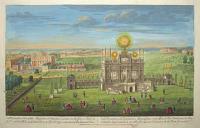
A Perspective View of the Magnificent Structure, erected in the Green Park for the Royal Fire Works exhibited the 27 of April 1749, on account of the General Peace. Veue Perspective du Batiment Magnifique...
London Printed for Robert Wilkinson No.58 Cornhill, & Bowles & Carver, No. 69 St.Pauls Church Yard.
Beautifully coloured engraving, J. Whatman watermark; plate 255 x 405mm (10 x 16"), with large margins. Some surface dirt mainly focused in the margins but also within the plate mark.
A view in Green Park of the structure made for the firework display celebrating the end of the War of the Austrian Succession (1740–1748) and the signing of the Treaty of Aix-la-Chapelle (Aachen). The structure was designed by the Franco-Italian architect, decorator and artist Giovanni Niccolò Servandoni (1695–1766). The illuminations were accompanied by music composed for the occasion and conducted by George Frideric Handel (1685–1759). The display was not as successful as the music itself: rainy weather caused many misfires, the right pavilion caught fire in the middle of the show, as well as several injuries.
[Ref: 56090] £360.00
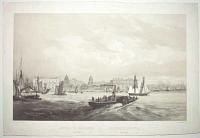
Hopital de Greenwich près London. Greenwich Hospital near London.
Dessiné et lith. par Jules Arnout. Imp. Lemercier, à Paris.
[Paris, Bulla Freres et Jouy, Editeurs. London, E. Gambart & Co. 25 Berners St. Oxf. St.] [n.d., c.1840.]
Tinted lithograph. Printed area 310 x 425mm (12¼ x 16¾"). Trimmed within publication lines at bottom. Faint time staining in the margins.
A view of Greenwich Hospital from across the river. Greenwich Hospital was completed in 1694 to designs by Christopher Wren and Nicholas Hawksmoor and functioned as a hospital for sailors until 1873. The distinctive split design was adopted to allow the already existing Queen's House to keep its view of the Thames. The Greenwich Observatory can be seen on the hill behind. The waterman on paddle steamer is in the foreground.
[Ref: 56993] £380.00
![[Hackney]](img-thumbnail/jpegs/56701.jpg)
[Hackney]
[C.J. Greenwood Del.t et Lith.] [****] & Son Litho. Ludgate Hill. London.
[London: n.d., c.1845.]
Scarce tinted lithograph. Image 220 x 345mm (8¾ x 13½"). Trimmed, losing most of the inscriptions, new margins added.
A railway bridge over a London street, with a locomotive passing.
[Ref: 56701] £180.00
(£216.00 incl.VAT)
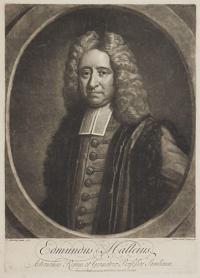
Edmundus Halleius. Astronomus Regius Geometriæ Professor Savilianus.
T. Murray pinx. 1712. John Faber Fecit 1722.
Printed for Bowles & Carver, No 69 St Paul's Church Yard London. [n.d., but watermarked 1817.]
Mezzotint with very large margins. 350 x 250mm (13¾ x 9¾").
Edmond Halley (1656-1742), astronomer, the first to calculate a comet's orbit. At the University of Oxford his studies of the theories of Sir Isaac Newton inspired him to write his own 'Principles', which he published with his own money in 1687. In 1721 he was made Astronomer Royal and began an 18 year study of the moon's complete revolution through its ascending and descending nodes. He also wrote another important treatise called Astronomiae Cometicae Synopsis (Synopsis on Cometary Astronomy), which he started in 1682 and published in 1705. In this he mathematically demonstrated that comets move in a elliptic orbits around the sun and how over time they would pass the same point. His accurate prediction of the return of what is now Halley's Comet in 1758 validated his theory. CS:173, this late state not listed. Ex: Collection of The Hon. C. Lennox-Boyd. Wellcome Library no. 3948i.
[Ref: 34139] £220.00
(£264.00 incl.VAT)
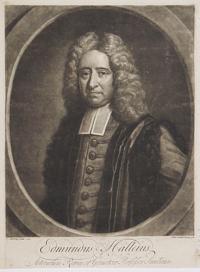
Edmundus Halleius, Astronomus Regius et Geometriae Professor Savilianus.
T. Murray pinx 1712. John Faber Fecit 1722
Sold by Faber in fountain Court near ye Fountain Taverne in the Strande
Mezzotint with very large margins on 3 sides, 1817 watermark; sheet 360 x 280mm (14¼ x 11"). Trimmed inside platemark lower edge.
Edmond Halley (1656-1742), astronomer. He went to the University of Oxford, where he studied the theories of Sir Isaac Newton. Because he was so intrigued with these theories, it inspired him to write the Principle which he published with his own money in 1687. In 1721 he was made Astronomer Royal and began an 18 year study of the moon's complete revolution through its ascending and descending nodes. During his life he also wrote another important treatise called Astronomiae Cometicae Synopsis (Synopsis on Cometary Astronomy). It was started in 1682 and published in 1705. In this he mathematically demonstrated that comets move in a elliptic orbits around the sun and how over time they would pass the same point. He had such an accurate prediction that when the comet (now Halley's Comet) returned in 1758, it validated his theory. Engraved from a portrait by Thomas Murray (Bodleian Libraries, University of Oxford). Murray's painting shows Halley pointing to a globe with buildings behind him, although the composition has been reduced and the background removed here. Ex: collection of the late Hon. C. Lennox-Boyd; CS II of III; for first state see ref. 34102.
[Ref: 34112] £240.00
(£288.00 incl.VAT)
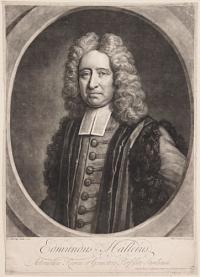
Edmundus Halleius, Astronomus Regius et Geometriae Professor Savilianus.
T. Murray pinx 1712. John Faber Fecit 1722
Sold by Faber in fountain Court near ye Fountain Taverne in the Strande
Mezzotint, sheet 365 x 260mm (14¼ x 10¼"). Repaired damage upper right; rare in this state.
Edmond Halley (1656-1742), astronomer. He went to the University of Oxford, where he studied the theories of Sir Isaac Newton. Because he was so intrigued with these theories, it inspired him to write the Principle which he published with his own money in 1687. In 1721 he was made Astronomer Royal and began an 18 year study of the moon's complete revolution through its ascending and descending nodes. During his life he also wrote another important treatise called Astronomiae Cometicae Synopsis (Synopsis on Cometary Astronomy). It was started in 1682 and published in 1705. In this he mathematically demonstrated that comets move in a elliptic orbits around the sun and how over time they would pass the same point. He had such an accurate prediction that when the comet (now Halley's Comet) returned in 1758, it validated his theory. Engraved from a portrait by Thomas Murray (Bodleian Libraries, University of Oxford). Murray's painting shows Halley pointing to a globe with buildings behind him, although the composition has been reduced and the background removed here. Ex: collection of the late Hon. C. Lennox-Boyd; CS i/iii ('one known')
[Ref: 34102] £290.00
(£348.00 incl.VAT)
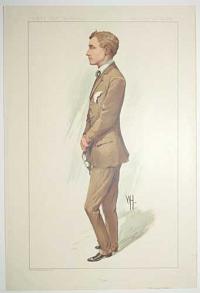
Vanity Fair Supplement. Men of the Day No. 2284. "Flight" (M.r Gustave Hamel).
WH [Wallace Hester]. Vincent Brooks, Day & Son Lt.d lith.
[n.d., 31 Jul 1912].
Chromolithograph with supplementary text, sheet 380 x 260mm (15 x 10¼"), large margins.
Full length portrait of the British aviator Gustav Wilhelm Hamel (1889 – 1914). He learned to fly at the Blériot school at Pau, France in 1910; after observing his first flight Louis Blériot commented that he had never seen a pilot with such natural ability. He paricipated in various competitions, flying displays and a pioneer in aviation; Hamel made the first cross-channel flight with a woman as passenger on 2nd April 1912, when he flew Eleanor Trehawke Davies from Hendon to Paris, he also enabled her to be the first woman to experience looping the loop on 2nd January 1914. Hamel disapeared over the English Channel on 23rd May 1914, it was speculated that this was sabotage but there was no trace of the aircraft and a fishing vessel on 6th July 1914 found a body that matched the description of Hamel.
[Ref: 56970] £120.00
(£144.00 incl.VAT)
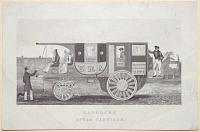
Hancock’s Steam Carriage.
[n.d., 1838.]
Steel engraving. Sheet 130 x 195mm (5¼ x 7¾"). Creased.
Frontispiece to Narrative of Twelve Years' Experiments .. Steam-Carriages on Common Roads. The steam omnibus ‘Era’, built by Walter Hancock (1799-1852) of Stratford to operate between Paddington, Regent’s Park and the City of London. The fare was sixpence per passenger; she was capable of carrying 14 passengers. Hancock operated steam road carriages from 1829 to 1840 (most famously 'Enterprise'), when heavy road tolls imposed by the Turnpike Acts made the business unprofitable. He continued to build engines for railways.
[Ref: 56876] £120.00
(£144.00 incl.VAT)
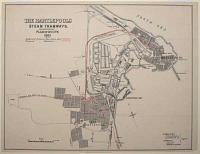
The Hartlepools Steam Tramways. Plan of Route 1883.
Waterlow Bro.s & Layton, Birchin Lane London.
[c.1883.]
Wood engraved map, overprinted in red. Sheet 310 x 400mm (12¼ x 15¾"). Original folds.
'The Hartlepools Steam Tramways' opened in 1884, running from Northgate in Hartlepool to Church Road in West Hartlepool. The company folded in 1891, after which the assets were purchased by 'Hartlepool Electric Tramways', who electrified the system and reopened in 1896, lasting until 1927.
[Ref: 56706] £160.00
(£192.00 incl.VAT)
![[William Henry Harvey] WH Harvey [facsimile signature].](img-thumbnail/jpegs/57192.jpg)
[William Henry Harvey] WH Harvey [facsimile signature].
T.H. Maguire 1850. M. & N. Hanhart Imp.t.
Published by George Ransome, Ipswich, 1851.
Lithograph. Printed area 340 x 245mm (14¼ x 9½"), with large margins. Foxing in margins.
Half-length portrait of William Henry Harvey (1811-6), Irish botanist and phycologist who specialised in algae and mosses. His 'Phycologia Australica' 1849 is one of the most important 19th century works on phycology. Australian interest. From the series 'Portraits of Honorary Members of the Ipswich Museum.'. Wellcome: 1313. Kivell & Spence: Not in.
[Ref: 57192] £260.00
(£312.00 incl.VAT)
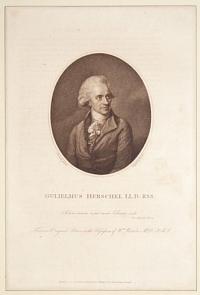
Gulielmus Herschel LL.D: RSS. From an Original Picture in the Possession of W.m Watson MD: FRS.
Painted by Abbott. Engraved by Ryder.
Publish'd as the Act directs 11th Feb.y 1788 by S. Watts, No 28 Walcot place Lambeth.
Stipple. Sheet 275 x 185mm (10¾ x 7¼"). With etching of Herschel's telescope, sheet 285 x 325mm. Trimmed within plate, mounted on album paper at edges.
Frederick William Herschel, Hanoverian astronomer, who came to England during the Seven Years's War and was the first President of the Royal Astronomical Society when it was founded in 1820. The owner of the painting, Sir William Watson, asked his friend Herschel to sit for Abbott, saying, ''When you are in town on full moon nights you may perhaps spare an hour early in the morning, & may sit three or four times running - & the thing may in this way be done without much inconvenience or loss of time''. The original oil is now in the National Portrait Gallery. The telescope in the second picture is Herschel's '40-foot telescope (i.e. with a 40-ft focal length), built in Slough between 1785-9. It was largest telescope in the world for 50 years. According to the scratched publication line under the image, it was 'Publish'd Feb 1 1791 by W. Herschel', issued in The Philosophical Transactions of t he Royal Society.
[Ref: 52941] £380.00
view all images for this item
![[Russian cryllic.]](img-thumbnail/jpegs/15764.jpg)
[Russian cryllic.] [Herschel.]
H. Pinhas sc.
[n.d. c.1800.]
Engraving. Plate 241 x 165mm. 9½ x 6½". Large margins.
Frederick William Herschel (1738-1822) was a British/Russian astronomer, technical expert and composer; emigrating to Britain aged 19. He is best known for his discovery of the planet Uranus in addition to several of its major moons such as Titania and Oberon.
[Ref: 15764] £60.00
(£72.00 incl.VAT)
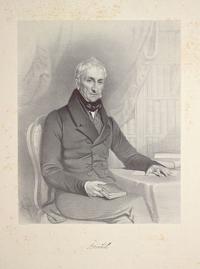
Bristol
T. H. Maguire. 1849. [Etched in plate.]
M & N Hanhart Imp.t
Lithograph on chine collé. 610 x 445mm (24 x 17½"), very large margins. Foxing in the margins. Small loss to lower left corner and tear in lower margin.
A three quarter length portrait of Frederick William Hervey (1769-1859), 1st Marquis of Bristol, seated with a book in his lap. From the Ipswich Museum Portraits series published by George Ransom in 1852: the sixty portraits of distinguished men of science were designed to commemorate the foundation of the museum in 1846.
[Ref: 57163] £130.00
(£156.00 incl.VAT)
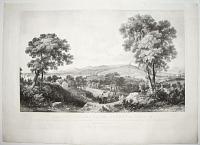
Hetton Colliery in the County of Durham. From which are raised at a depth of three hundred Yards the Hetton & Lyons Wallsend, the Lyons Main, the Old Ducks & Denmark Main Coals, with a View of the Horizontal & Inclined Planes Engines & Staiths on the Bank of the River Wear near Sunderland. Projected and Managed by Arthur Mowbray Esq.r
Drawn on Stone by J: D: Harding. Printed by C: Hullmandel.
[n.d. c.1825.]
A very rare and scarce lithograph. 610 x 851mm. 24 x 33½". Tears in the margins, large margins.
Hetton Colliery, as seen to the far right, was connected to the River Wear at Sunderland, seen to the far right, by a railway engineered by George Stephenson between 1819 and 1822.
[Ref: 19803] £550.00
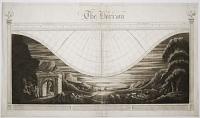
The Horizon. Plate 5.
G. Wright Esq. inv et del. et pinx. Engraved by V. Woodthorpe, No 29 Fetter Lane London.
Published Dec.r 1st 1801 by R. Woolsey Islington.
Rare aquatint. 440 x 780mm (17¼ x 30¾"). Trimmed to plate at sides, some creasing.
An astronomical diagram, illustrating the celestial horizon. Underneath is large illustration of a bay lit by moonlight, with a man with a telescope sitting by a ruined classical arch.
[Ref: 40914] £360.00
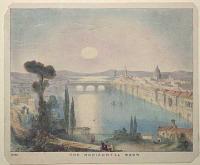
The Horizontal Moon
[London: David Bogue, c. 1845.]
Coloured lithograph on card. Sheet 150 x 190mm (6 x 7½"). Edges clipped at corners.
An illustration of a optical effect that makes the moon look oval, over an Italian city. Plate 92 of 'The Beauty of the Heavens: a pictorial display of the astronomical phenomena of the universe' by Charles F Blunt.
[Ref: 56793] £85.00
(£102.00 incl.VAT)
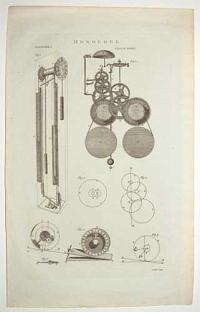
Horology.
I. Taylor Sculp.
[n.d., c.1800.]
Engraving. 350 x 210mm (13¾ x 8¼") very large margins.
A plate with seven figures relating to to clock-making, including a contemporary clepsydra (waterclock) and clockwork. From an encyclopedia.
[Ref: 57126] £80.00
(£96.00 incl.VAT)
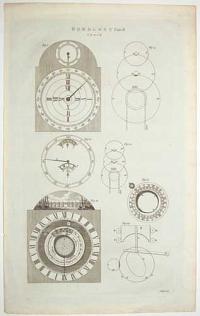
Horology. Tab. II. Clock.
I. Taylor Sculp.
[n.d., c.1800.]
Engraving. 350 x 210mm (13¾ x 8¼"), very large margins.
A plate with seven figures relating to to clock-making, including a contemporary clepsydra (waterclock) and clockwork. From an encyclopedia.
[Ref: 57131] £80.00
(£96.00 incl.VAT)
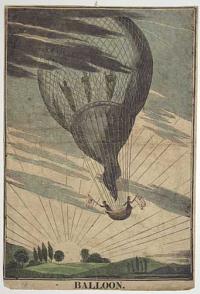
Balloon.
[n.d., c.1820].
Engraving with hand colour, sheet 235 x 155mm (9¼ x 6¼"). Cut. Creased. Some surface dirt.
A blue hot air balloon decorated with people floats above the green countryside towards a beaming sun. Two people wave flags from within the basket. Possibly depicting James Sadler (1753 – 1828) and Captain Paget's flight that took off from Mermaid Gardens, Hackney and descended near Tilbury Fort, Essex 12th August 1811.
[Ref: 56933] £95.00
(£114.00 incl.VAT)
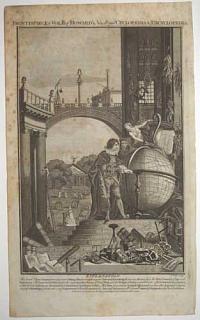
Frontispiece to Vol. II. of Howard's New Royal Cyclopaedia & Encyclopaedia.
G. Noble sculp.
Published as the Act directs by Alex.r Hogg at the Kings Arms, No 16 Paternoster Row, London [n.d., c.1788].
Engraving. 370 x 240mm (14½ x 9½"). Foxing. small margins.
A composite scene within classical architecture, with two men examining a globe, surrounded by reference to sciences, with multiple instruments and books.
[Ref: 57045] £160.00
(£192.00 incl.VAT)
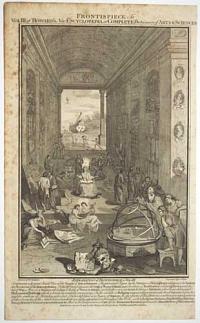
Frontispiece to Vol. III. of Howard's New Royal Cyclopaedia & Encyclopaedia.
Frawn by W. Chalmers. Engraved by G. Noble.
Published as the Act directs by Alex.r Hogg at the Kings Arms, No 16 Paternoster Row, London [n.d., c.1788].
Engraving. 370 x 240mm (14½ x 9½"). Foxing. Trimmed on right margin.
A composite scene within a library, with men examining an orrery, surrounded by reference to arts and sciences, with instruments and books.
[Ref: 57049] £160.00
(£192.00 incl.VAT)
![[Sir William Huggins] Spectroscopic Astronomy](img-thumbnail/jpegs/56851.jpg)
[Sir William Huggins] Spectroscopic Astronomy" Vanity Fair. April 9th. 1903. Vincent Brooks, Day & Son Ltd. Lith.
Spy [Leslie Ward].
Chromolithograph. Sheet 385 x 265mm (15¼ x 10½")
Sir William Huggins (1824-1910), English astronomer best known for his pioneering work in astronomical spectroscopy.
[Ref: 56851] £95.00
(£114.00 incl.VAT)
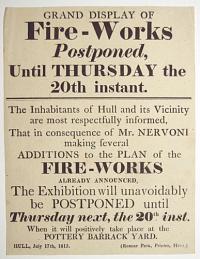
Grand Display of Fire-Works Postponed, Until Thursday the 20th instant. The Inhabitants of Hull and its Vicinity are most respectfully informed, That in consequence of Mr. Nervoni making several Additions to the Plan of the Fire-Works Already Announced, The Exhibition will unavoidably be Postponed until Thursday next, the 20th Inst. When it will positively take place at the Pottery Barrack Yard.
(Robert Peck, Printer, Hull.)
Hull, July, 17th, 1815.]
Scarce letterpress handbill. Sheet 220 x 170mm (8¾ x 6¾").
A firework display, probably celebrating the Battle of Waterloo the previous month. Signor Nervoni was conductor of fire works at Vauxhall Gardens.
[Ref: 57174] £260.00
(£312.00 incl.VAT)
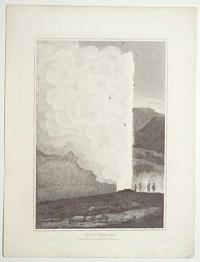
New Geyser.
Sketched by Sir G.M. Engr.d by E. Mitchell.
Published by A. Constable & C.o Edinburgh. [n.d., c1811]
Engraving with etching, plate 230 x 170mm (9 x 6¾") Tiny bit of creasing and very small tear in margin. Trimmed bottom centre.
A view of a geyser erupting in Iceland. Travel in aquatint and lithography Abbey 160.9.
[Ref: 57069] £95.00
(£114.00 incl.VAT)
![[Chinese astronomy instruments] Sphere Armillaire Zodiacle. 1. Machine.](img-thumbnail/jpegs/56801.jpg)
[Chinese astronomy instruments] Sphere Armillaire Zodiacle. 1. Machine. [&] Sphere Equinoxiale. 2. Machine. [&] Horizon Azimuthal. 3e Machine. [&] Quart de cercle de 6. pieds de rayon. 4e Machine. [&] Sextant de 8. pieds de rayon. 5.e Machine.
[Plate 2 only] F. Ertlinger sc.
[n.d., c.1697.]
Five engraved plates. Each c. 145 x 80mm (5¾ x 3¼"). Trimmed. Laid on card in hinges on right.
Five plates from 'Nouveaux memoires sur l'etat present de la Chine' by Jesuit missionary Louis le Comte, showing some of the instruments in the Peking Observatory., including a large quadrant, sextant and armillary sphere.
[Ref: 56801] £320.00
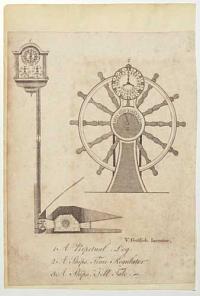
V. Gottlieb Inventor. 1. A Perpetual Log. 2. A Ships Time Regulator. 3. A Ship's Tell Tale.
[n.d., c.1790.]
Engraving. Sheet 160 x 120mm (6¼ x 4¾"). Trimmed within plate, laid on album paper.
Diagrams of ship's instuments invented by Valentine Gottlieb, an immigrant who settled in Lambeth in the 1770s. He successfully lobbied the government to install his design of a mechanical perpetual ship’s log to two newly-designed fast postal packets commissioned in 1790 for the North American and West Indian mail service. The December 1791 issue of the European Magazine contained a variation of this engraving plus explanatory text of this group of related navigational instruments. See http://journal.sciencemuseum.ac.uk/browse/issue-15/valentine-gottlieb/
[Ref: 57043] £80.00
(£96.00 incl.VAT)
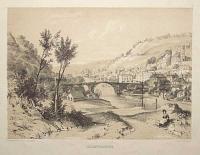
Ironbridge.
Drawn from Nature and on Stone by I.C. Bayliss. Printed by C. Hullmandel.
[n.d., c.1856.]
Scarce tinted lithograph. Printed area 220 x 290mm (8¾ x 11½"), with large margins.
A view of Ironbridge in Shropshire, with the iron bridge built 1779-81 that gave the town its name.
[Ref: 56948] £380.00

Illuminate! Illuminate! Illuminate! Crowns, Stars. Wreaths, Ties, Letters, and Devices of every description, for Gas or Variegated Lamps, on Loan from 6s. each device, and 1s. 6d. per dozen Lamps, at Walmsley's Furnishing Ironmongery Warehouses, 125, 137. 128, London Road, Southwark, London. Order Early!
Alfred Boot, Printer, Dockhead, Bermondsey.
29th May, 1856 [old ink mss.].
Scarce letterpress handbill. 85 x 190mm (3¼ x 7½"). Notches in top edge, mounted on card.
An advertisment for outdoor lights.
[Ref: 57176] £180.00
(£216.00 incl.VAT)
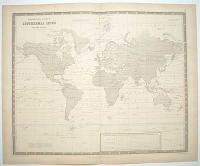
Humboldt's System of Isothermal Lines of the Globe. By Dr H Berghuas, Professor of Geography Berlin.
Drawn in the Engravers School for Geography, Potsdam, Dec.r 1842. Engraved by W. & A.K. Johnston.
Edinburgh; John Johnston and W. and W. & A.K. Johnson; Glasgow; Robert Weir Lumsden & Son [n.d., c.1844].
Engraved map with some original hand colour. Sheet 540 x 670mm (21 x 26½"). Some ink offset.
A map of the world on Mercator's Projection, with isothermal lines linking areas of equal temperature. Of interest are the markings for the furthest points north and south reached by explorers, including Parry and Scoresby in the Arctic and Cook, Weddell, D'Urville and Ross in the Antarctic.
[Ref: 57124] £130.00
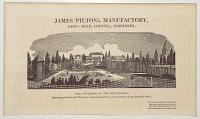
James Pilton's Manufactory, King's Road, Chelsea, Middlesex. The Interior of the Menagerie, Displaying Ornamental Works for Country Residences, and Specimens of the Invisible Fence.
Mercier and Chervet, printers, 32, Little Bartholomew Close. [n.d. c.1809.]
Wood engraving on india. India 120 x 195mm (4¾ x 7¾").
It was in 1809 when James Pilton's Manufactory in King's Road advertised its fences, verandahs and other ornamental metalwork. Guildhall: q8052663.
[Ref: 56981] £60.00
(£72.00 incl.VAT)
![Wm Jardine [facsimile signature].](img-thumbnail/jpegs/57190.jpg)
Wm Jardine [facsimile signature].
T.H. Maguire 1849. M. & N. Hanhart Lith. Printers.
[Ipswich: George Ransome, 1852.]
Lithograph. Printed area 350 x 240mm (13¾ x 9½"), with large margins. Foxing, tear in right margin.
Half-length portrait of Sir William Jardine (1800-74), Scottish naturalist best known for his 'Naturalist's Library', 1833-66. He also wrote 'the Ichnology of Annandale', which include descriptions of fossils found on his ancestral estate. From the series 'Portraits of Honorary Members of the Ipswich Museum.'. Wellcome: 1519.
[Ref: 57190] £190.00
(£228.00 incl.VAT)
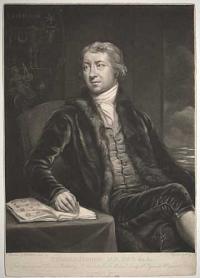
Edward Jenner, M.D. F.R.S. &c.&c. From an original picture Painted by J. Northcote, for the Medical Society of Plymouth & Plymouth Dock.
Painted by J. Northcote Esq.re R.A. Engraved by W. Say.
Publish'd Aug.t 20 1804 by Thomas Palser, Surrey St Westminster.
Fine mezzotint. 430 x 305mm (17 x 12"). Trimmed to plate, publisher's inscription weakly inked.
Edward Jenner (1749-1823), discoverer of vaccination. His hand flicks the pages of a book to a page 'Pustules of the Cow Pox in its successive stages'. Top left image of "sacred cow" with Ancient (David?) symbols. W. 1527.
[Ref: 57005] £490.00
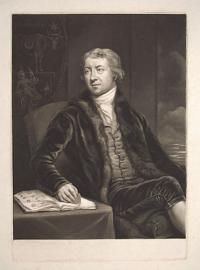
[Edward Jenner, M.D. F.R.S. &c.&c. From an original picture Painted by J. Northcote, for the Medical Society of Plymouth & Plymouth Dock.]
[Painted by J. Northcote Esq.re R.A. Engraved by W. Say.]
[London Published Jan.y 1. 1803, by W Say. No 5. Quicksett Row, New Road, opposite Fitzroy Square..]
Fine mezzotint, very scarce proof before letters. 430 x 305mm (17 x 12"), large margins. Glued to backing sheet at corners.
A seated portrait of Edward Jenner (1749-1823), discoverer of vaccination. His hand flicks the pages of a book to a page 'Pustules of the Cow Pox in its successive stages'. See NPG D19467 for the published state. Ex: Collection of The Hon. C. Lennox-Boyd.
[Ref: 57171] £1,250.00
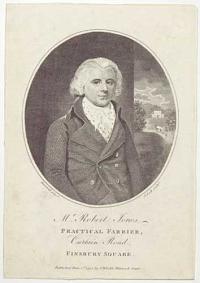
M.r Robert Jones, Practical Farrier, Curtain Road, Finsbury Square.
Marshall pinx.t. J. Scott. Sculp.t.
Published June 1.st 1797 by J. Wheble, Warwick Court.
Engraving with etching, sheet 160 x 115mm (6¼ x 4½"). Thread margins.
Oval portrait of the farrier Robert Jones, illustration to the 'Sporting Magazine'. Wellcome: 1545; O'Donoghue.
[Ref: 57055] £75.00
(£90.00 incl.VAT)

Optics. Plate XV. Principles and Construction of the Kaleidoscope.
J. Pass sc.
Engraved for the Encyclopoedia Londonensis, 1820.
Coloured engraving. 270 x 215mm (10¾ x 8½"). Trimmed into plate on three sides. Slight staining.
[Ref: 56819] £120.00
(£144.00 incl.VAT)
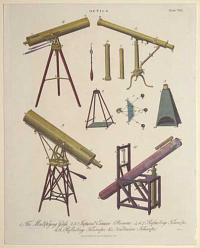
Optics. Plate VIII. 1. The Multiplying Glass. 2,3. Improve Camera Obscura. 4 to 7 Refracting Telescope. 8,9. Reflecting Telescope. 10. Newtonian Telescope.
J. Pass sc.
Engraved for the Encyclopoedia Londonensis, 1820.
Fine coloured engraving. 270 x 215mm (10¾ x 8½"). Trimmed into plate on three sides.
[Ref: 56866] £130.00
(£156.00 incl.VAT)





![Vanity Fair Supplement. [Men of the Day No. 2219.]](img-thumbnail/jpegs/56969.jpg)

![[The Grand Jubilee Celebrations in London's Parks.]](img-thumbnail/jpegs/49810.jpg)

![John Edw. Gray [facsimile signature].](img-thumbnail/jpegs/57191.jpg)






![[Hackney]](img-thumbnail/jpegs/56701.jpg)






![[William Henry Harvey] WH Harvey [facsimile signature].](img-thumbnail/jpegs/57192.jpg)

![[Russian cryllic.]](img-thumbnail/jpegs/15764.jpg)









![[Sir William Huggins] Spectroscopic Astronomy](img-thumbnail/jpegs/56851.jpg)


![[Chinese astronomy instruments] Sphere Armillaire Zodiacle. 1. Machine.](img-thumbnail/jpegs/56801.jpg)





![Wm Jardine [facsimile signature].](img-thumbnail/jpegs/57190.jpg)




